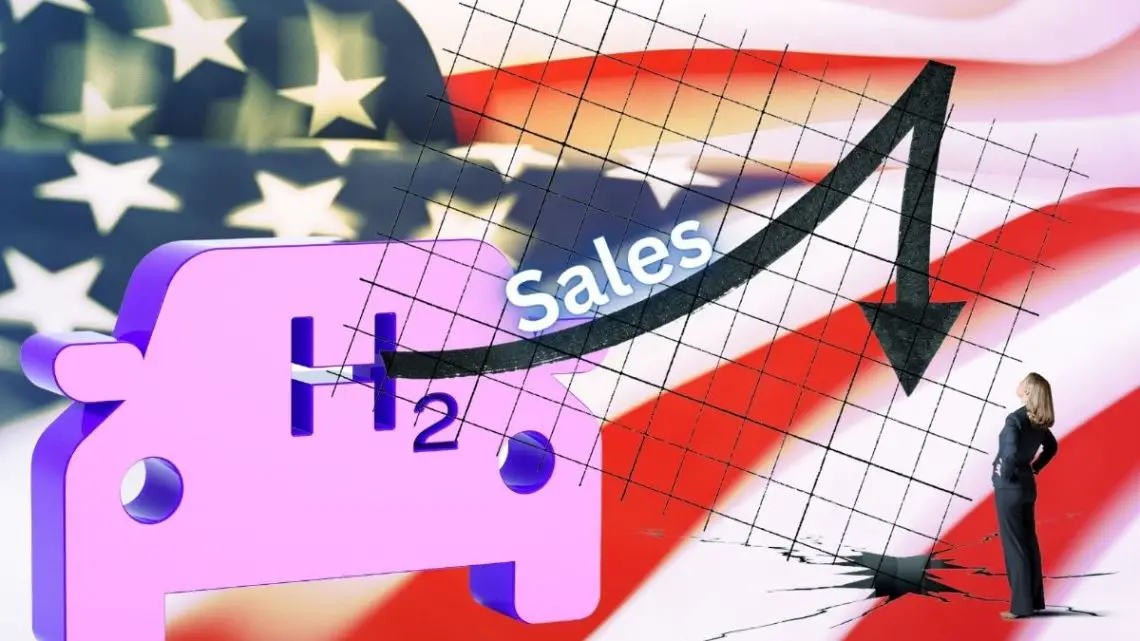
US Hydrogen Fuel Cell Car Sales Plummeted at the Start of 2023
May 30, 2023H2-powered passenger vehicles saw a 30 percent reduction in sales during the first quarter.
Hydrogen fuel cell car sales in the United States, which have been quite limited to date, saw a striking decrease in the first quarter of 2023, having dropped by almost 30 percent when compared to the same quarter in 2022.
Sales of H2 passenger vehicles have been nearly non-existent in the US and now they’re dropping.
Even in California, which is the only state in which hydrogen fuel cell car sales are being made, sales are falling. This has caused many people to wonder whether H2 will ever be a going concern in the passenger vehicle market or if battery electric vehicles (EVs) have secured their hold on the zero-emission car market.
Data from the Hydrogen Fuel Cell Partnership showed that during the first quarter of this year, there were 725 new H2-powered passenger vehicles sold in the United States. The data was collected through Baum and Associates and “sales data is based on car sales sold by a dealer to a retail or fleet customer.”
The hydrogen fuel cell car sales were essentially insignificant compared to the 3.7 million total vehicles sold.
When compared to the total number of vehicles sold during Q1 2023, the 725 H2-powered vehicles barely existed. Comparatively, battery electric cars saw 257,507 new registrations during that same time period. This represented a year-over-year increase of 63 percent.

In California alone, there were 87,525 new battery electric vehicles registered in the first quarter, and another 16,470 plug-in hybrid electric vehicles (PHEVs) sold in Q1.
That said, proponents of H2 and automakers in that market do not see the Q1 figures as necessarily disheartening. The reason is that it is a single quarter and not necessarily a trend. Looking one quarter earlier, into Q4 2022, there were 720 units sold, meaning that the number was essentially remaining steady, instead of experiencing a sheer drop as the quarter turned over.
Sales are needed soon
 Still, those figures remain quite small and without some new growth in hydrogen fuel cell car sales in coming quarters, it will be difficult to cut into a market that has become so heavily dominated by electric vehicles.
Still, those figures remain quite small and without some new growth in hydrogen fuel cell car sales in coming quarters, it will be difficult to cut into a market that has become so heavily dominated by electric vehicles.
Ready to test your knowledge on the most abundant element in the universe? Take our fun and engaging Hydrogen Quiz now! [forminator_quiz id=”58712″]



 With over 15 years of reporting hydrogen news, we are your premier source for the latest updates and insights in hydrogen and renewable energy.
With over 15 years of reporting hydrogen news, we are your premier source for the latest updates and insights in hydrogen and renewable energy.
Why buy a car which cannot be refueled? As long as H2 fueling stations remain practically non-existent, of course sales of H2 cars will remain bur a blip in total new car sales.
As a purely personal opinion based on being old –
This is an interesting chicken and egg issue. Further complicated by the fact that home electricity generation potentially can reduce the costs of EV charging, this coupled with the charge at home, (your car can be fully charged when you leave) reducing some pressures on shared charging infrastructure for commuter use of cars.
Hydrogen is very important. As unique markets develop (such as heavy construction, buses and goods vehicles) will be adopted and drive the new infrastructure that will take a generation to build. In which time there should be enough wind & solar power generation to support ‘green’ hydrogen production to support the market demand.
For car use market intervention, such as government stimulus will be required in the short to medium term driven by political dimensions and national situations. i.e. a country with a limited electricity grid and or abundant access to hydrogen in various colours as bi products to existing environments.
Basic problems are finding refuelling station that has gas, and if you have to pay from you pocket, cost or H2 is very high – almost double ($26.75) than what was just 6 months ago ($14.75).
Because the so called “free market capitalism” has no profit incentive nor in all reality do corporate entities have the capability to fully build out large scale H2 infrastructure and without government interest or political will which is pathetically weak, regardless of all the bs “renewable energy roadmaps” that strictly rely on the fairy tale “free market” corporate saviors, the US will lag behind countries that choose to take meaningful infrastructure projects that can provide millions of jobs and clean energy use in key commercial industries that can make significant inroads to getting off of fossil fuels and reducing the hyper acceleration of climate change.